Welcome to PyreSwap! - The Short Version
The following provides a brief overview of the strategies involved in PyreSwap, and the Greater PyreSwap Ecosystem.
For more elaborate information on strategy, please read The Long Version.
Introduction to Diagrams
In order to better communicate strategy, this section consists of Diagrams and Descriptions.
Put simply, the descriptions accompany the diagrams, in order to enhance the information they represent.
While the complete taxonomy and edificial theory of diagrams is a much broader subject than what can be expressed here, we will begin by identifying and describing four general types of diagrams used in this documentation.
- Structural
- Procedural
- Conceptual
- Behavioral
Structural Diagrams
Structural diagrams provide a visual representation of the static arrangement and relationships among the components within a system. They focus on the organization and composition of elements without considering the sequence of actions or behaviors. These diagrams are essential for understanding the architecture and design of a system at a high level. They help in identifying the key elements and their interconnections, aiding readers in understanding the system's structure. Structural diagrams facilitate communication by providing a shared understanding of the system's composition.
Procedural Diagrams
Procedural diagrams depict the sequence of steps or actions required to accomplish a specific task or objective within a system. They emphasize the flow of control, decision points, and outcomes, guiding users through the procedural logic. These diagrams are instrumental in documenting processes, workflows, and algorithms, aiding in analysis, optimization, and troubleshooting. Procedural diagrams help in clarifying complex procedures, ensuring consistency and accuracy in their execution. They serve as valuable tools for training, onboarding, and continuous improvement efforts.
Conceptual Diagrams
Conceptual diagrams offer an abstract representation of the fundamental concepts, relationships, and structures within a system or domain. They focus on conveying overarching ideas and principles, abstracted from specific implementation details. These diagrams aid in establishing a shared understanding, guiding discussions and decision-making processes. Conceptual diagrams are valuable for modeling complex systems, providing a high-level perspective that transcends technical intricacies. They facilitate communication by presenting concepts in a clear and concise manner, fostering alignment and collaboration across diverse audiences.
Behavioral Diagrams
Behavioral diagrams capture the dynamic interactions and behaviors exhibited by a system's components over time. They illustrate how entities within the system communicate, collaborate, and respond to stimuli or events. These diagrams emphasize the sequencing of actions, conveyance of information, and state transitions, enabling users to comprehend system behavior comprehensively. Behavioral diagrams facilitate analysis and validation of system requirements, helping to ensure that the intended behavior aligns with expectations. They play a crucial role in the design, implementation, and testing phases of system development.
Diagrams are often misinterpreted based on a misunderstanding of the type of diagram being displayed. "Structural" and "Conceptual" are often confused for each other, and "Behavioral" diagrams can get misconstrued for "Procedural" ones. Make sure to consider possible alternatives, and their subtle differences, for any diagram being interpreted.
Not all diagrams will fit neatly into one of the above types: Some might fit into multiple, and others may fit into none.
Diagrams - The Short Version
The following diagrams are provided to help aid the userbase's understanding of PyreSwap and the GPSE.
Passive Staking versus Active Staking

The distinction between Active Staking and Passive Staking is one of the key concepts associated with PyreSwap.
Positive and Negative Percentages
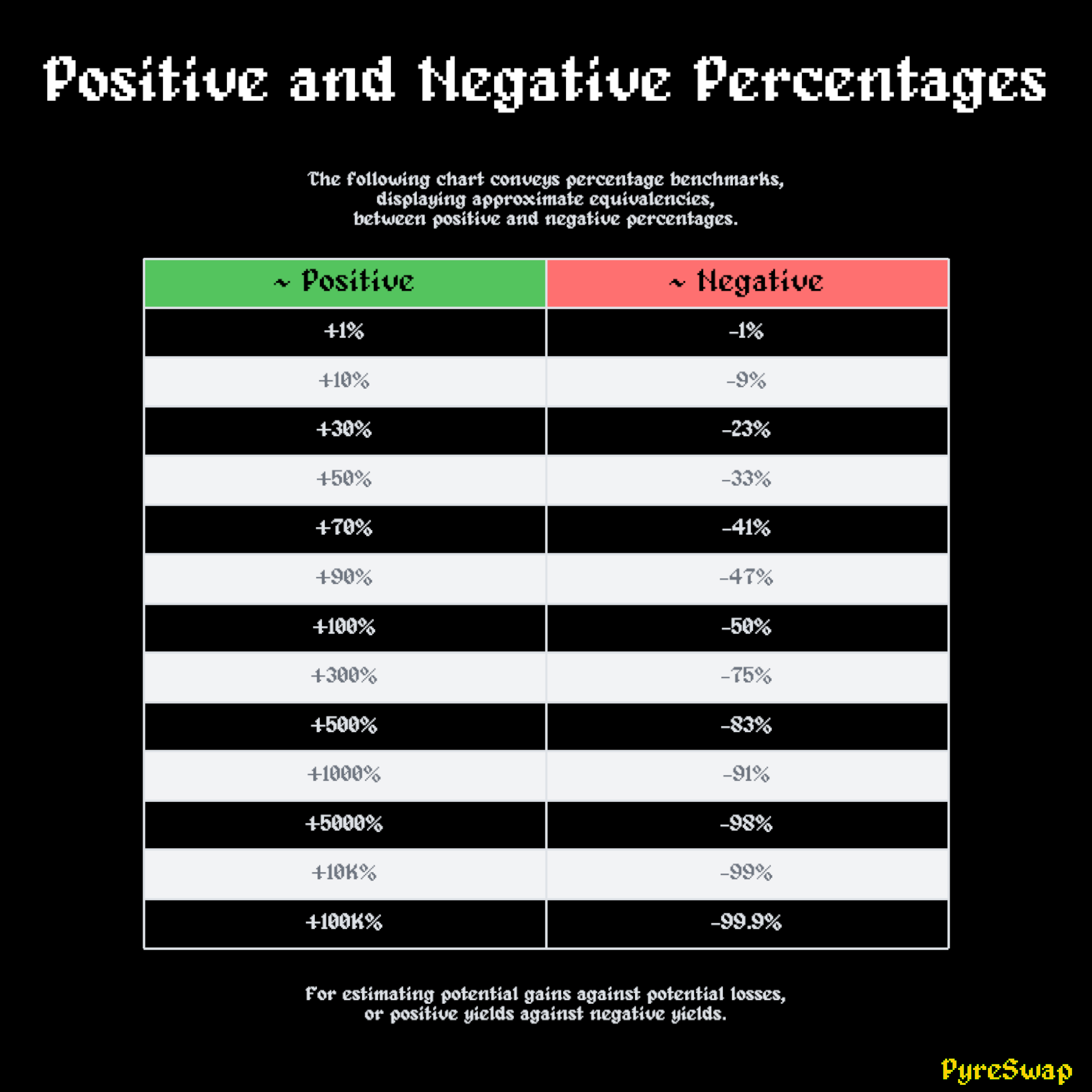
In the climate of web3, it is recommended that users become familiar with the expression of changes and differences between those of positive and those of negative percentages.
Bifecta versus Trifecta

The Greater PyreSwap Ecosystem is large and diverse enough to provide for variegation in the roles of its actors, which permits a higher degree of sustainable tokenomics and economic equilibrium.
Tokenomic Lifecycles of the Greater PyreSwap Ecosystem
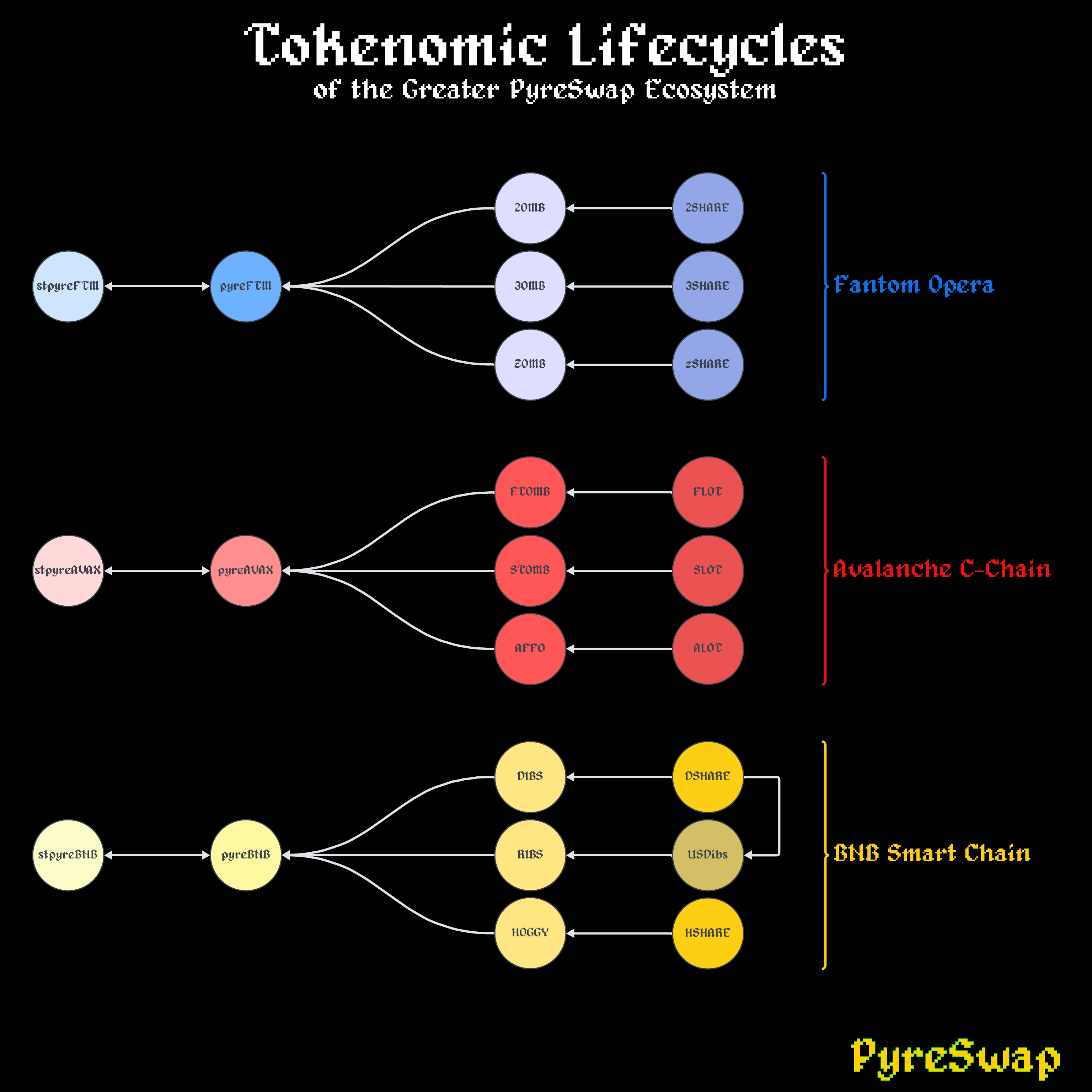
The GPSE as a whole is comprised of a number of different tokenomic systems and associations. Learning the mechanisms that permit these tokenomic relationships, as well as their utility and directionality, is key to understanding their potential risks and rewards.
Incantation WitchVault Example Sequence
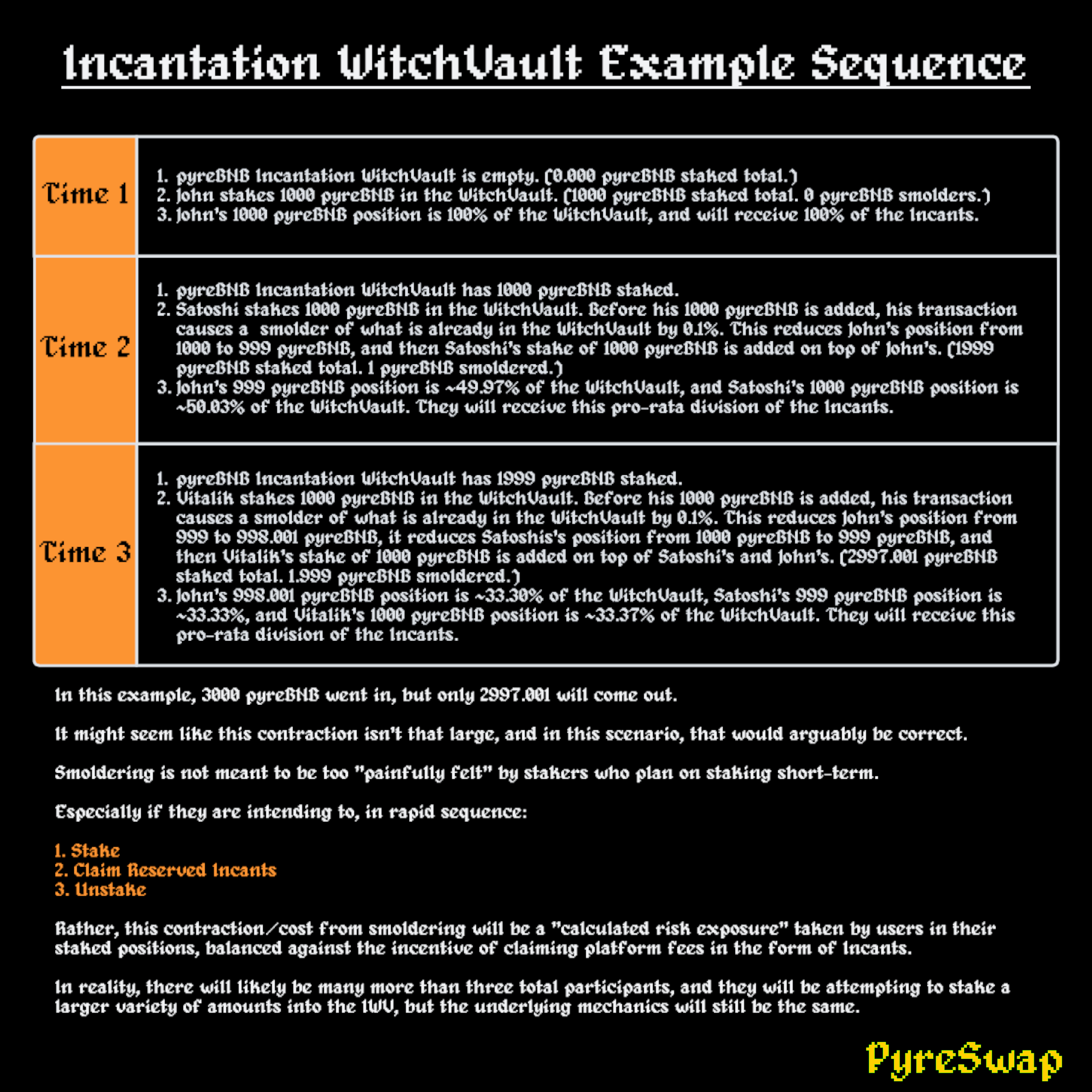
The above diagram is meant to explain the risk of negative yield, by narrating a sequence of events that account for how smoldering can affect the Incantation WitchVault stakers, and their positions.
Meeding Strategy Tree
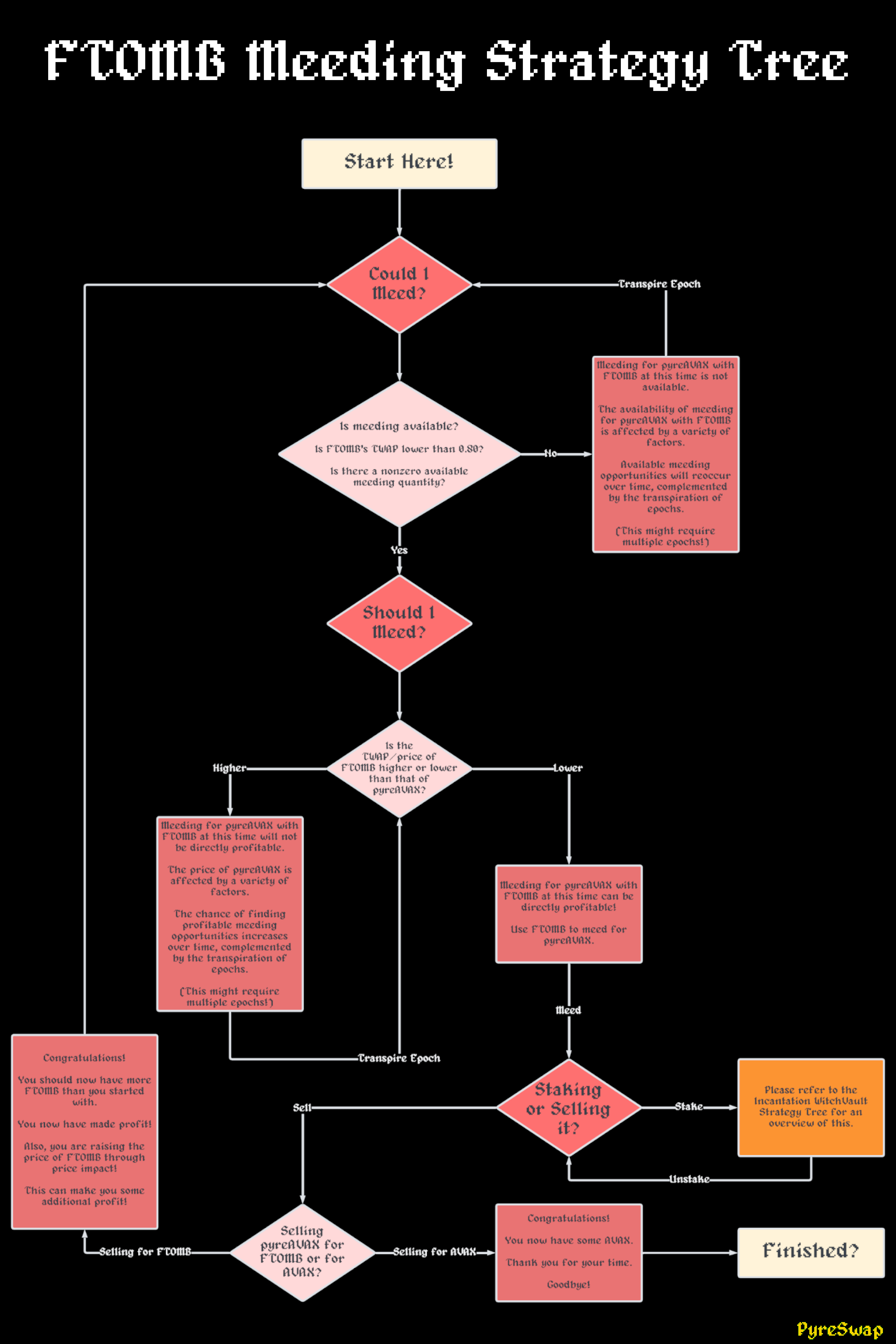
The above diagram is a heuristic flowchart for meeding and/or meeditrage.
Meeditrage is a portmanteau of “meed” and “arbitrage.”
Essentially, a user can perform the following sequence of actions:
- Hold a certain amount of peg-coin, originating from a previous print or a previous buy.
- Meed an amount of that peg-coin, converting them for their associated meed-coin. (Meeding ratios are unique to each coin.)
- Sell that meed-coin for the original peg-coin, which causes positive price impact on the original peg-coin, and negative price impact on the meed-coin.
This maneuver can be profitable to the user who performs it, if executed at a satisfactory price differential.
This maneuver can also be unprofitable to the user who performs it, if executed at an unsatisfactory price differential.
The Incantation WitchVault Strategy Tree
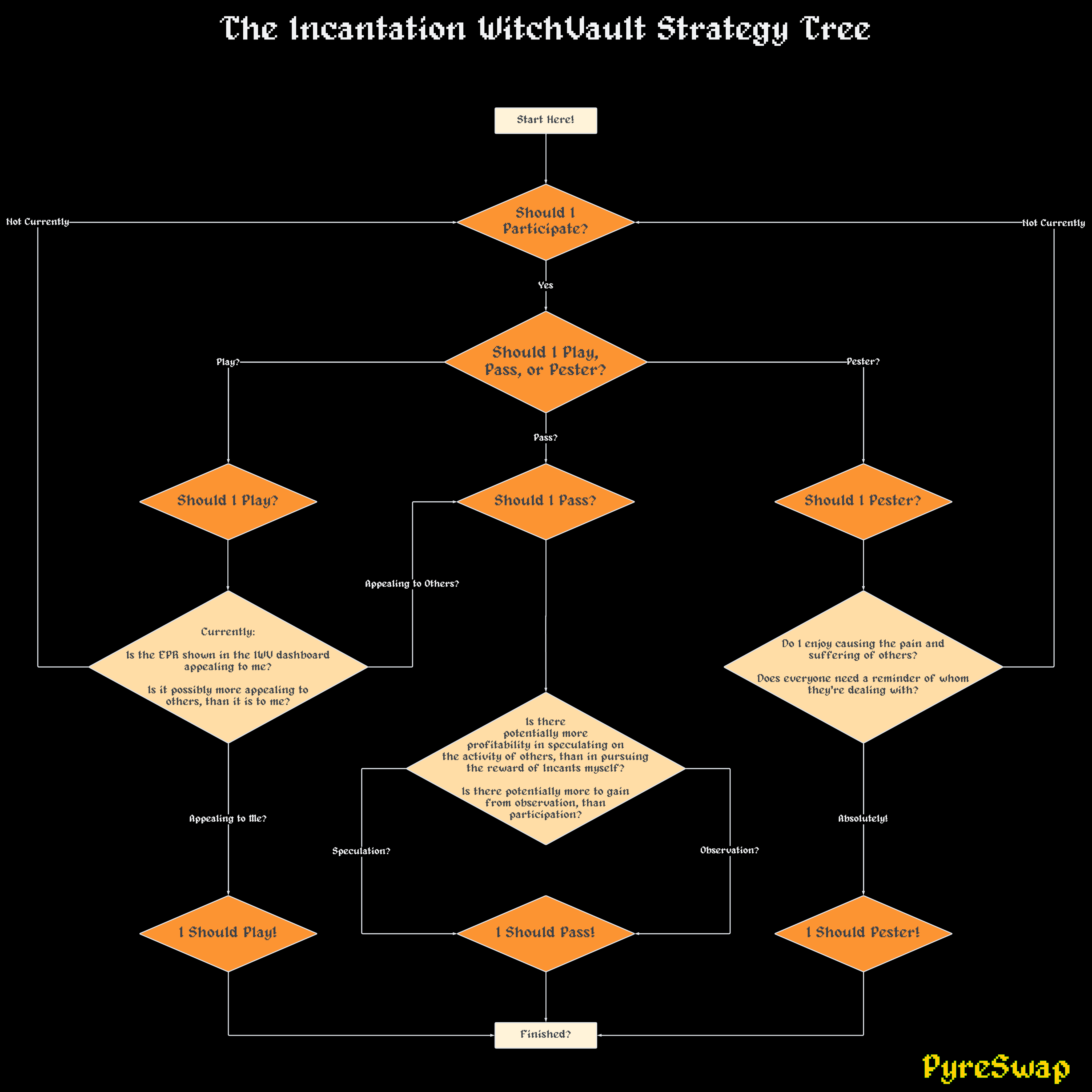
The three general strategic approaches to the Incantation WitchVault are categorized by the following names:
- Playing
- Passing
- Pestering
Playing can be described as any and all approaches to the pursuit of claiming Incants as yield. Generally speaking, a participant may decide to “play” when the observed parameters are within their risk appetite, but may deviate to another style when parameters change.
Passing can be described as any decision a participant makes to forego playing the Incantation, (meaning the pursuit of claiming Incants,) and is a decision that can be made at any time by a participant, and even reversed.
Pestering can be described as any behavior a participant chooses to engage in that is focused more on the antagonism of other participants, rather than their own individual benefit. (Although the two are not mutually exclusive.) Participants can engage in pestering whenever they choose to, and pestering can be a complement to any “playing” or “passing” strategy, or its own unique style commitment.
For more information on how to assess risk and plan strategy for PyreSwap's Incantation WitchVault, please read How to Assess Risk and Plan Strategy for PyreSwap's Incantation WitchVault.
Smoldering Offset Targets
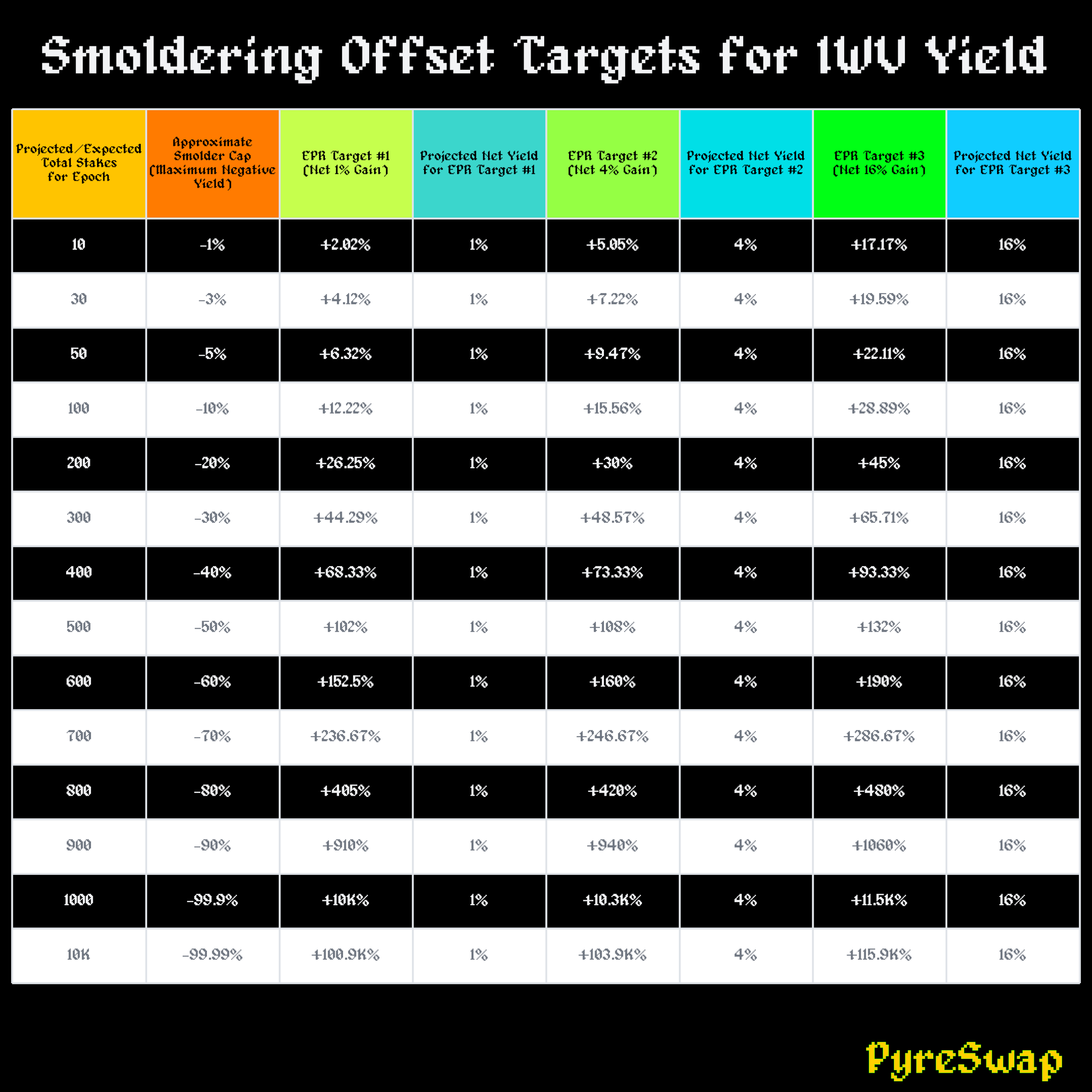
By learning to understand the Incantation WitchVault's dashboard and its displayed metrics, users can begin to predict future sequences of events, and even estimate possible outcome scenarios, for which they can adjust the size of their position accordingly, in advance.
Meeding Metrics
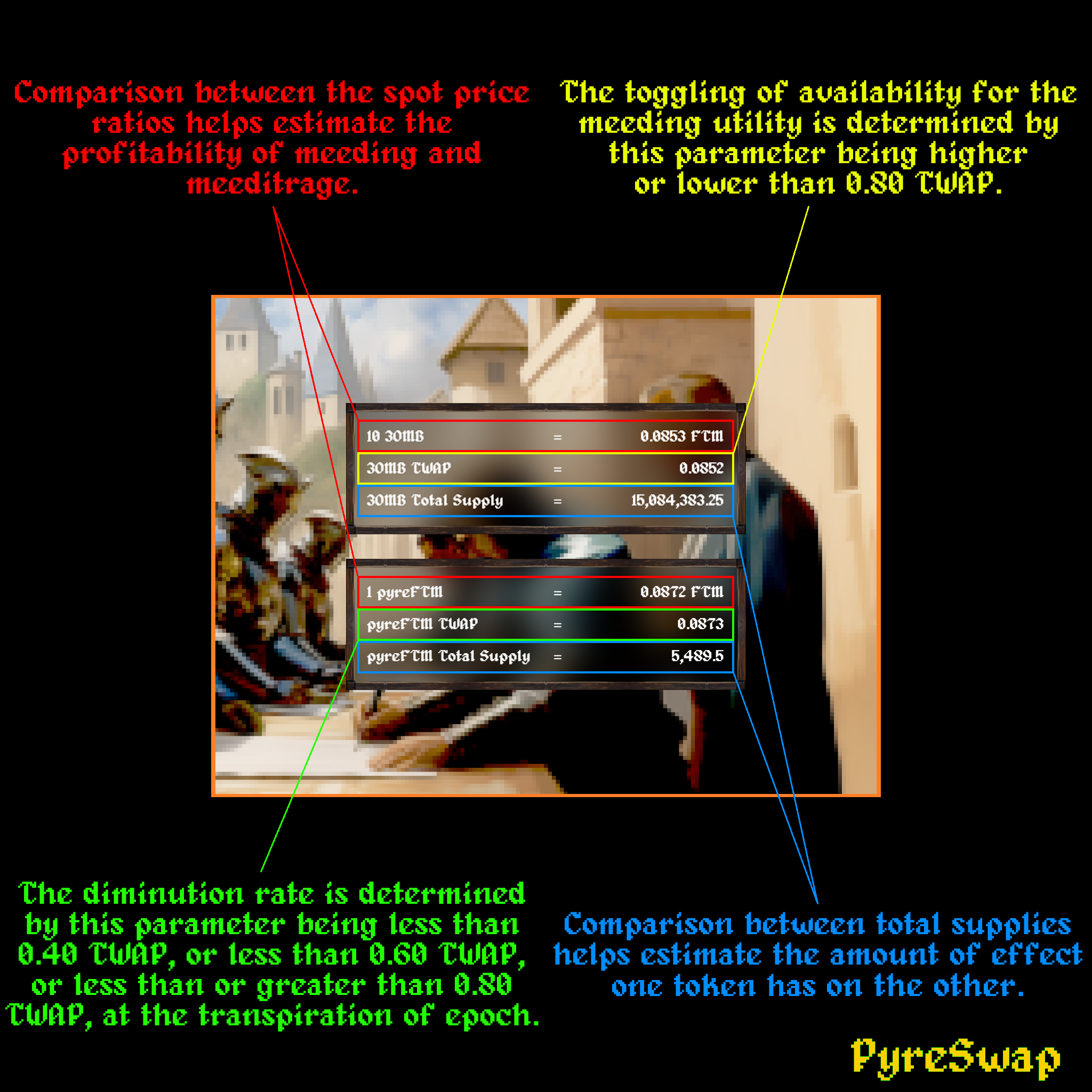
The above is an explanation of the metrics shown on the Meeding interface, to better assist users in their decision-making.
The Velvet Rope Pattern

The Velvet Rope Pattern (VRP) is a price action pattern of pyreAVAX/pyreBNB/pyreFTM, which occurs somewhat regularly, as a behavioral manifestation of their underlying tokenomics.
It is one of the features of PyreSwap that allow for a degree of consistency in Fundamental Analysis.
The Greater PyreSwap Ecosystem's Chronometry
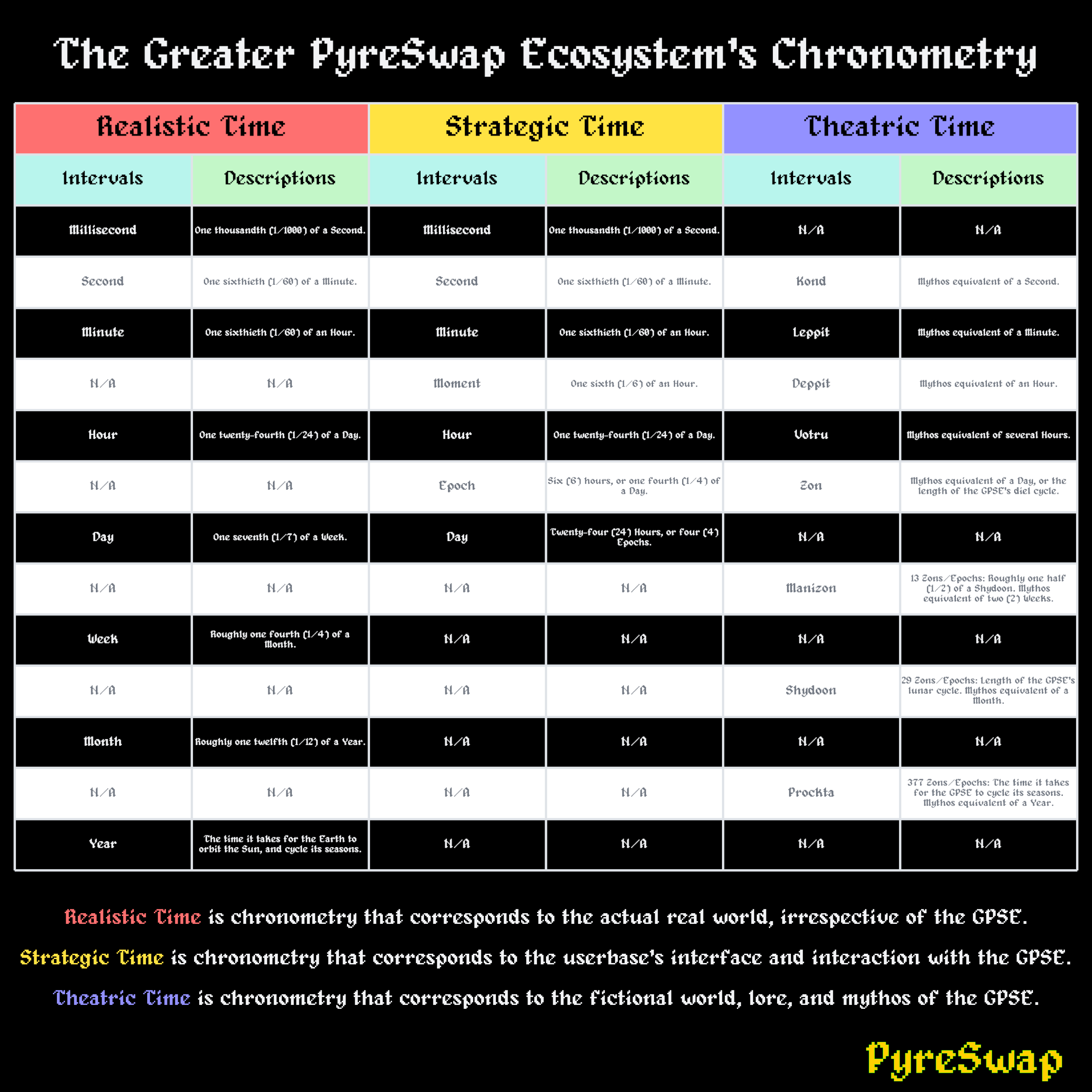
The chronometry of the GPSE is divided into three categories, to dispel confusion and aid communication among the userbase.
In the context of the GPSE:
- Realistic Time is time as it is experienced and measured by the [assumedly human] userbase, in general.
- Strategic Time refers to the intervals of time made significant by the game mechanisms of the GPSE.
- Theatric Time refers to the narrative or storyline time, which will become more of a factor in later phases of PyreSwap's roadmap.
In Strategic Time, an Epoch is comprised of Hours, which are comprised of Moments, which are comprised of Minutes.
The last Hour in an Epoch is known as the Ultimate Hour.
The last Moment in an Epoch is known as the Ultimate Moment.
The last Minute in an Epoch is known as the Ultimate Minute.
Venn Diagram of the GPSE

To clarify the terminology used to categorize the GPSE's tokens and their associations, this diagram is provided to illustrate the configuration and organization of the integrated instruments.
Overview of Opportunities in the Greater PyreSwap Ecosystem: Phase I
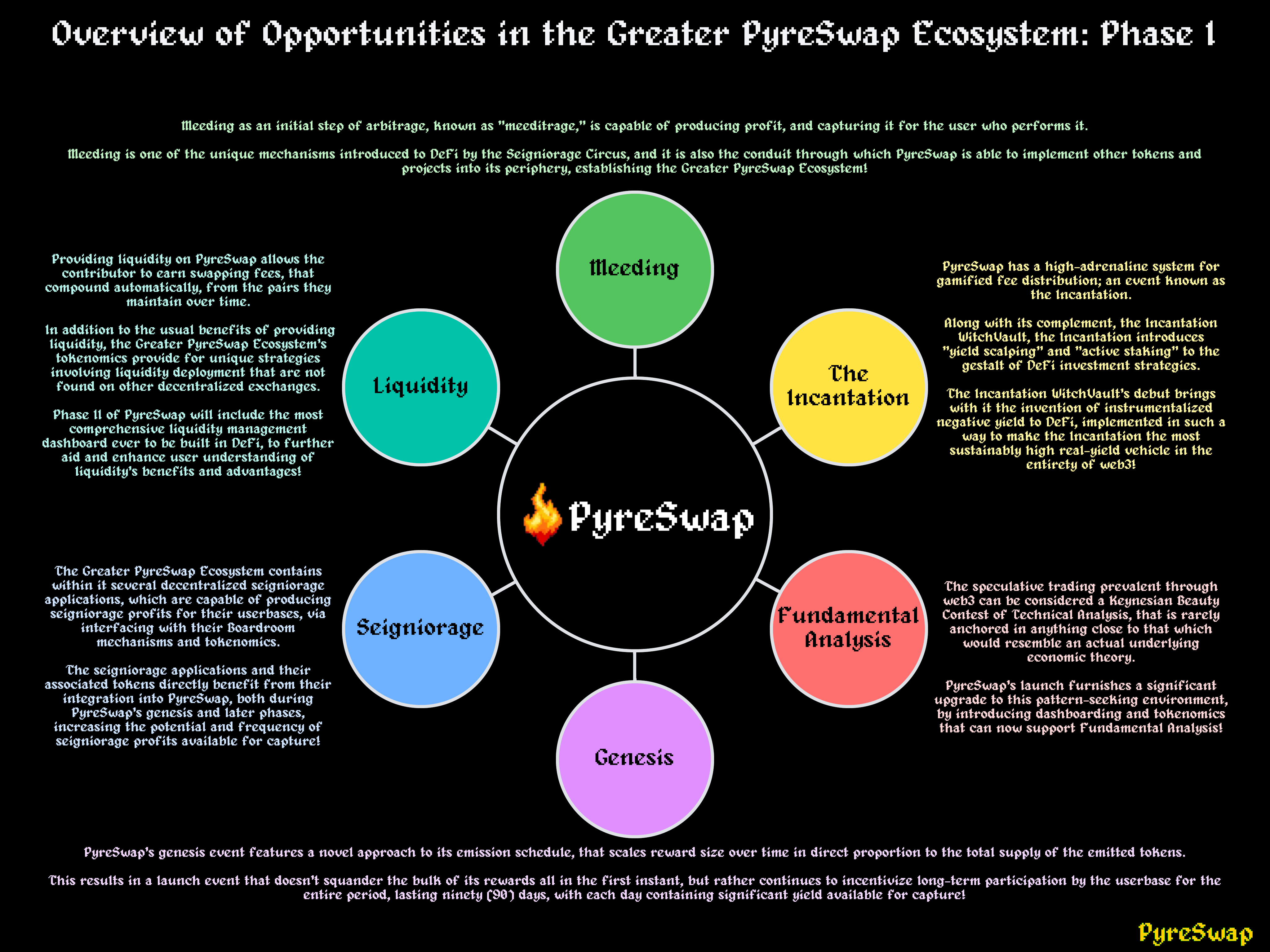
This diagram provides an overview of the opportunities Phase I of PyreSwap makes available to its userbase.
Trading Tokens versus Holding Tokens
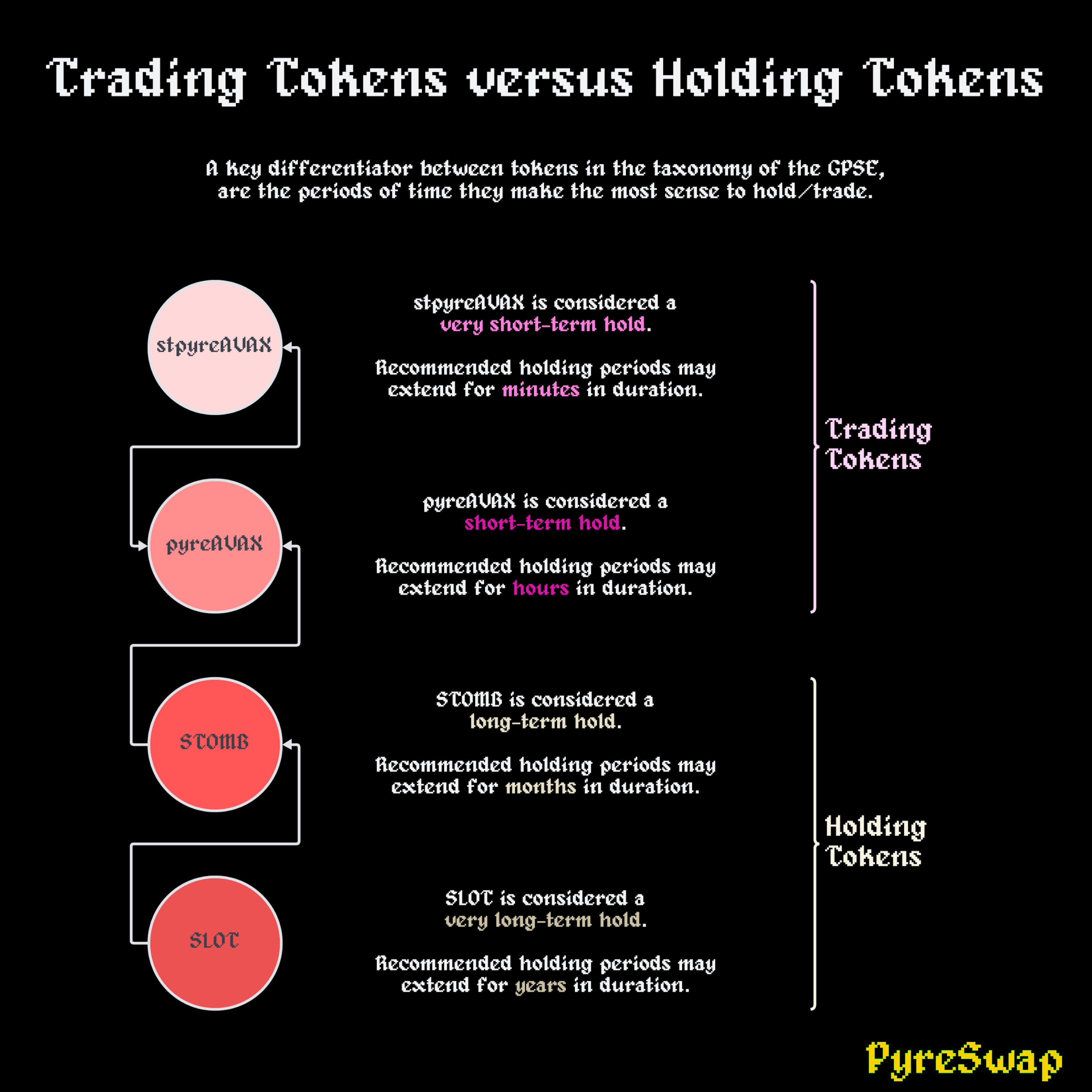
One of the more unique features about PyreSwap and the GPSE, is that certain tokens are not necessarily well-suited to "hodl" culture.
Rather, the opportunities and benefits these tokens can provide to users are designed for quick sequences of meeds, stakes, trades, as well as other possible maneuvers, to be revealed in the future.
Mnemonic Devices - The Short Version
The following mnemonic devices are provided to help aid the userbase's understanding of PyreSwap and the GPSE.
The Lowest & The Latest

This short poem came about spontaneously, as a makeshift solution for quickly explaining why the Velvet Rope Pattern regularly re-emerges on the price chart, as a manifestation of the aggregated risk analysis for the Incantation, taking place simultaneously in the minds of the userbase.
It refers to a singular user as "a witch," which is in alignment with the larger GameFi aspect of PyreSwap and the GPSE.
Higher & Higher

Written somewhat similarly, this non-rhyming poem, (if it can be called that,) succinctly explains how the Incantation is able to sustain itself, over time and repetition, as the highest real-yield mechanism in web3.